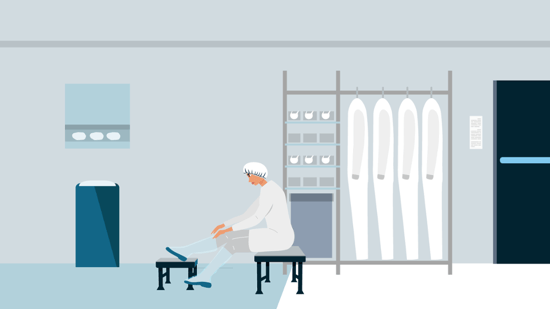Selecting the right cleanroom apparel helps maintain the required level of cleanliness and prevent contamination. You’ll need to consider more than your cleanroom classification to select the right combination of apparel products.
Cleanroom Apparel Selection Fundamental Series - Part 2
What Are Your Internal Cleanliness Specifications?
Specifications for your cleanroom apparel should consider these factors:- What’s the process or application?
- What are the chemicals being used in the process?
- What are the acceptable upper and lower limits of particles?
- Do you need to control for electrostatic discharge (ESD) sensitivity?
- How much coverage is required? (Your process may require a cleanroom coverall for full coverage or specific coverage from cleanroom gowns, lab coats, sleeves, head, face, and/or shoe covers).
- How long will operators wear the apparel?
- Reusable or disposable? (Reusable apparel requires proper laundering and sterilization to maintain cleanliness. Commercial laundry services require minimums so reusable apparel can be economical for larger cleanrooms with more operators but uneconomical for smaller cleanrooms with fewer operators. Disposable apparel is suited for handling radioactive or chemical materials that can leave a residue and can be worn as an undergarment for reusable apparel for the most critical cleanliness requirements).
Cleanroom Garment and Vendor Selection Recommended Practices
Understanding the Performance of Disposable Apparel Substrates
Your cleanroom apparel, whether disposable or reusable, should be made from low-linting materials such as synthetic fabrics, polyester, or microfiber. These materials – or substrates – minimize the release of particles that can contaminate the cleanroom environment. For disposable apparel, the most common substrate materials include:
-
Spunbond polypropylene is made from 100% virgin spunbond polypropylene that encapsulates larger particles. It is ideal as a bouffant cap, lab coat, or shoe cover. This nonwoven, lightweight, breathable fabric provides a low-cost solution for protection against dry, larger particulates.

-
Polyethylene-coated polypropylene (PCPP) is polypropylene but with a polyethylene coating. PCPP is also impervious to liquids, lint-free, and has excellent tensile and tear resistance. It provides protection to workers exposed to splashes from certain chemicals, liquids, and particulates. PCPP is not breathable but is more comfortable than impervious, nonbreathable materials like polyethylene.

-
Cross-linked polyethylene (CPE) in low density is impervious to liquids, lint-free, and does not run or bleed when exposed to water. CPE is ideal for shoe covers. It’s not breathable, so it’s hot for operators to wear as caps, face covers, or garments.

-
Microporous is a highly breathable, non-linting film that is bonded with nonwoven fabric, offering an ultra-cool, comfortable alternative to Tyvek® or other similar materials for caps, face covers, and garments. It provides superior performance against non-toxic particulates, liquids, spray, and dust.

How Do Seams And Stitching Impact Performance?
It’s important to understand how seams and stitching impact the performance of disposable apparel. For example, unfinished edges of fabric can release fibers and the pinholes from stitching needles permit the release of operator-generated particles. Raw edges and pinholes should be covered to encapsulate particles. There are two common styles of seams:
-
Unbound/serged seams can be single-needle or double-needle stitched. Single-needle stitching leaves the cut edge and needle pinholes untreated, posing a contaminant threat from loose fibers and operator-generated particles. Double-needle stitching finishes the cut edge with a seam, reducing but not eliminating the risk of loose fibers and particles.
-
Bound/encapsulated seams have a ribbon of fabric with pre-finished edges that are double stitched or heat sealed (fused) over the entire seam, eliminating any exposed cut edges and needle pinholes – and the potential contaminant risk. Bound seams also improve seam strength and garment durability.
Along with bound seams, additional consideration should be given to stitches per inch and thread material. Higher stitch counts produce more robust seams.
What Should You Look For In Cleanroom Apparel Construction?
The construction of cleanroom garments should minimize the number of seams and all other components such as zippers, snaps, and straps. The seams and components must be cleanroom compatible. If the garment undergoes a sterilization process, it must also be gamma compatible.
IEST publishes Recommended Practice CC003 on cleanroom garments to help you understand requirements for yarn and seams.
Rely on Garment Manufacturers with Cleanroom Experience
Once you’ve considered these apparel features for your application, reputable apparel manufacturers with extensive experience in cleanroom applications – like Valutek –can provide product quality test data and advice to help you make the optimal selection to meet your cleanliness and comfort requirements.
Be mindful that the majority of disposable apparel products in the market are designed for general PPE use, and not necessarily for cleanroom applications. We can use 35 years of experience in controlled environments to find the best solutions for your cleanroom apparel.
Explore More Sources:
Cleanroom Apparel Selection Fundamentals: What You Need to Know
Cleanroom Apparel - All You Need to Know [Video]
Disposable Apparel - Comparison of Substrate Materials [Video]
Valutek’s Cleanliness Classifications

Valutek
Valutek is one of the first and few manufacturers to offer a full product portfolio of best-in-class cleanroom products. Since 1988, our controlled environment consumables are helping leading organizations operate their cleanrooms in a consistently stable state.
Related Articles
- Valutek

- 27 July 2023
Four Steps to Close the Cleanliness-Comfort Gap in Cleanroom Apparel
There are trade-offs between cleanliness and comfort when it comes to cleanroom apparel. The ...
- Valutek

- 25 July 2023
Cleanroom Apparel Selection Fundamentals: What You Need to Know
Cleanroom apparel serves two functions. First, cleanroom apparel encapsulates the operator to...
- Valutek

- 20 December 2023
Cleanroom Documentation Selection Fundamentals: Paper, Notebooks and Notepads
Paper is used daily in controlled environments to document work instructions, manuals, job orders,...


